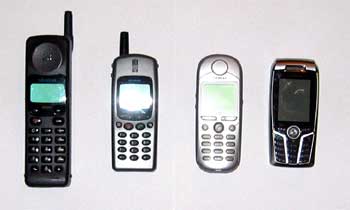Yes, this phrase segment is a small adaptation to another big slogan. But I think it is a very appropriate one… A long time ago one of the major players in the German technology industry, SIEMENS, developed, designed and produced mobile phones in Germany.
- In 1996 the market share of SIEMENS mobiles is 40 %.
- In 1997 I bought my very first mobile phone, a SIEMENS “S4â€.
- In 1997 SIEMENS introduced the first mobile phone (S10) with a “colour display†(just 4 different colours). SIEMENS produced 3,5 million devices; NOKIA made a 5 time figure. The SIEMENS objective for 2001 was a market share in the world of around 15 percent.
- In 1998 the “SL10â€, the first mobile with a shift mechanism is introduced to the market.
- In 2000 I bought my second mobile phone, a SIEMENS “S25â€. In 2000 SIEMENS introduced the “S35â€, a mobile phone, which is specified for business needs.
- In 2001 Dagmar bought her second mobile phone, a “S35â€.
- During the years 2001 – 2004 the loss within the mobile phone business segment amounts to 726 million EUR. According to the German business journal “manager magazineâ€, management style (“par ordre du mouftiâ€) seemed to be a major problem during this time. Probably due to this and due to lacking analysis of trends the organisation was not able to keep up with the competition in terms of design trends as well as technology trends in the mobile business.
- In 2002 I bought my third mobile, an Ericsson “T39â€.
- In 2003 the company started a fashion design driven mobile, the “Xelibri†mobiles, which is a huge flop.
- In 2005 I bought my last mobile by SIEMENS, a “S65â€, for a single reason: The mobile phone interface in my car allows a S65.
In 2005 SIEMENS “sold†this business segment to BenQ; BenQ got the business segment and an amount of 420 million EUR. (Other sources say that the amount was 350 million EUR before tax.) The market share of SIEMENS mobiles declined from 8 % (when the business segment belongs to Siemens) to 3,2 % in September 2006. At the end of September 2006 BenQ headquarter stoped all financial transfers to the German company; the German company gets into insolvency.

(From left to right: S4, S25, S35, S65. The S4, S25, S35 still work, the latest S65 is out of order since 12/2006.)
Â
Lessons learned
I think it is very frustrating that a large organisation like SIEMENS is not able to set trends in a consumer business segment or even to identify those trends. According to various sources the company failed with different steps
- Time to market: The organisation was not able to develop new technology fast enough and to take it to the market place
- Identification of trends: The organisation did not discover the trend for full colour displays, mp3-players and integrated cameras
- Use of trends and technology: Very early the company produced a mobile phone with a slide mechanism, but the organisation was not able to identify this trend and to use this advantage.
- Focus on a very specific design: Basically the “Xelibri†mobiles can be seen as good idea to achieve a design advantage. (I need to quote from SIEMENS: “We envisage the scenario where people will own many fashion accessory phones and wear the one that matches their mood, the occasion, or their attire”, said George Appling, President of Xelibri.) But the design represents a focus on one (!) specific demand.
So what can be learned in terms of an analysis of environment? Well, we have to be fair, the external analysis is not that easy. According to THOMMEN and ACHLEITNER this step of strategic planning is not an easy task for three reasons. Basically this analysis can be described as badly structured matter, which does not know a definitive solution. Due to the large amount of data the selection of relevant information remains a problem. To identify chances and threads for the organisation it is requested to analyse both current situation as well as possible developments. Hence the uncertainty of forecasts represents a third reason.
To reduce the above mentioned problems it is recommended to structure the environment into different segments and sub-segments. Segments could be general environment, business market and industry; where technology and economy could be sub-segments of the general environment. For SIEMENS a better analysis in terms of the general environment, in particular of technology and social psychological trends, as well as of the business market (focus on qualitative data) would have been recommended.
The creation of different scenarios can be seen as a way to manage the uncertainty of forecasts. Hence it would have been helpful, if SIEMENS had also not only focused on design issues or even a fashion scenario. A second, more technology driven scenario, would have been one solution.
